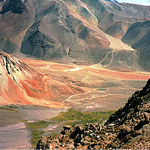Juan Mamani is a success story. He started at his father's side extracting gold from Amazonian rivers in the Madre de Dios region of Peru when he was six. His family could never afford to send him to school. Now in his late 30s, he owns his own river-mining rig and hopes that income from gold dust will keep his own six-year-old son in school.
Mamani's success comes amid tragedy. Lawless mining camps are springing up across the fringe of the Amazon, creating hotbeds of forced prostitution and astronomical levels of pollution. Laborers work in contaminated mud pits and end the day breathing mercury fumes as they purify gold in open oil drums. Despite such misery, Mamani is among the many miners who defend such "artisanal mining" as one of the few paths out of poverty in rural South America.
He and his colleagues pose a double threat to the formal mining industry as it seeks to expand production of gold, silver and copper. Not only do they contribute to the reputation that mining is a dirty, dangerous game, creating a public relations challenge for larger mines. They also form an important political constituency that can stop a multinational company in its tracks.
Slowly, though, companies, nongovernmental organizations (NGOs) and governments are learning how to shift mineral production from small-scale outfits to bigger, more easily regulated operations. They are working with the multitudes dredging the Amazon basin, the hard-rock miners picking gold and silver out of veins in the Andes mountains, and the small copper miners eking out a living in Chile's Atacama desert.
Informal and Illegal
South Americais replete with lessons for resource companies seeking to make changes. Government-led efforts to "formalize" the miners have had varying degrees of success. Private companies, while traditionally relying on police and military force to impose their projects on local communities, have in recent years found more cooperative strategies that, although slow, may end up with healthier mine-community relations than what exists today.
Per kilogram of metal, informal and illegal mines are more dangerous for workers and do more environmental harm than large mines, where standards are easier to enforce. For example, in river mining in the Amazon rain forest, informal sites are worked over briefly and abandoned. The buffer zone around the Tambopata National Reserve in Peru, an area of protected rain forest, lost 1,400 hectares in the 10 months ending in September due to mining, according to a study by CICRA, a conservation society for the protection of the Amazon, which based its findings on satellite photography. Peru's mining ministry said the Madre de Dios region, which is pocked with illegal mine sites, produced 18 tons of gold in the first nine months of this year. By comparison, there is the country's biggest formal mine — Chaupiloma, operated by Minera Yanacocha, a company that is majority-owned by Newmont Mining of Colorado. Chaupiloma produced 29 tons of gold through September from a 10,000-hectare property that it exploits year after year.
That is not to say that formal mining is without controversy. Yanacocha's attempt to build a new mine, called Conga, in the same Cajamarca state as Chaupiloma, has been met by protests and roadblocks over the possible loss of water for agriculture, leading President Ollanta Humala to declare a state of emergency in the region as of December 5.
As gold prices have soared in the past five years, informal mining — another form of small-scale mining, which uses old-fashioned practices dating back to the 19th century — has boomed. In Colombia, locals have spent centuries hammering nuggets of gold out of the Andes, generally without a land title. Recently, miners have swarmed into the long-exploited mountainsides of Antioquia, the department where Medellin is the capital.
"Antioquia is the most polluted place I've seen in my life," says Marcello Veiga, a professor at University of British Columbia's N.B. Keevil Institute of Mining Engineering. Illegal and informal miners in the country make up a workforce of 200,000, producing 30 tons of gold a year, he wrote in a recent joint paper in the journalScience of the Total Environment. The country's total production is about 50 tons a year, says the Colombian Mining Information System web site.
"Small-scale mining is a much larger problem than [most people] realize," says Logan Hennessy, a liberal studies professor at San Francisco State University, who has conducted research in such mining in Guyana. "A large mine is localized…. Its risks are huge — you can have acute exposure to a spill or a leak. But small mining is a problem because it's dispersed. It can be undetected in the forest for weeks or even months without anyone knowing about it."
A Long List of Concerns
A gold rush is now in progress across the Amazon lowlands, from Guyana to Peru. Teams use diesel-powered pumps to suck up the beds and banks of rivers, pouring the slurry through sluices to trap the heavy grains of gold. When a day draws to a close, they purify the gold by cooking it in mercury, using two to three grams of mercury for every gram of gold. Most of that ends up in the environment and workers' bodies.
Save the Children, an international NGO focused on halting sexual exploitation, says the mining camps are rife with child prostitution. "It's been proven that it's taking place," notes Teresa Carpio, the NGO's director in Peru. In contrast, formal mining camps often have municipal child protective services and schools with the mining companies paying teachers' wages.
Campaigns against mining, legal or otherwise, often use footage from illegal mining. An anti-mining video in Colombia, for example, shows photos of surface-mining and describes conditions in the Antioquia informal mines, conflating them with the problems presented by large, formal mines. The ad was released in 2010 during a government debate about the environmental impact of an open-pit mine planned by Greystar Resources of Canada, which was eventually rejected.
Aside from turning public opinion against mining, small-scale mines pose a threat to their formal counterparts. In recent years, companies have sought to take over deposits long exploited by small-scale miners in Venezuela, Colombia and Brazil, hoping to apply modern technology to known high-grade deposits. They sometimes face resistance from the artisanal miners, who see the professionalization of the mine as a route to unemployment.
Seeking to drive out artisanal miners is a hopeless task. Even if it were somehow possible, it would indeed increase rural unemployment while all but eliminating the discovery of new deposits. Many, if not most, new mines are built on sites discovered by informal prospectors.
Traditionally, companies in that situation have relied on state security forces to "get rid of the guys," says University of British Columbia's Veiga. In the jungles of Venezuela and Peru, military and police forces regularly blow up dredges and seize heavy machinery. But porous borders, thick forests and a gold price above US$1,500 an ounce make such successes ephemeral. Last year, Peru announced that it had eliminated high-powered dredges from the Madre de Dios River. Weeks later, at least one dredge was back on the river. This year, military forces returned and destroyed another 75 vessels.
Another lost cause is for governments to give miners title to their plots and hope they then sell out to a larger, more easily regulated company. "Governments try to 'formalize' guys," Veiga says. "How do you do it? They don't have education, they are ignorant [and] they don't have technical assistance. Instead, they try to give titles so they can then negotiate with big miners. They should educate and organize these guys first." Artisanal miners are unlikely to sell out, he adds, because they lack skills for other types of employment. Those who do accept a payout may well return to small-scale mining elsewhere.
Companies have had a mixed record of good community relations. However, some junior mining firms are trying to negotiate with artisanal miners rather than evicting them. A case in point: Gran Colombia Gold, another Canada-based mining company, has been negotiating with small-scale miners. At a site called Frontino, individuals have for years gone underground into a company mine, and then sold their day's haul to the company. This year, such artisanal miners, along with some formal mine staff, grew increasingly concerned about the prospect of mass layoffs and protested. Union leader Rafael Tobon was killed on July 26 at the site. A statement from the union blamed "paramilitary structures" for the violence.
After months of negotiations, observers expect Gran Colombia to reach an agreement with locals in early 2012, says Gabrial Bayona, a natural resources analyst at Interbolsa, a brokerage in Medellin. "They are working toward cooperative outcomes," he notes. "They realize they can't just force out the community." Gran Colombia didn't return a call for comment.
But Gran Colombia's community relations are at times tense. The company has said its exploration camp at Mazamorras in Colombia was burned down in October. Local reports indicate that the arson was part of protests mounted by farmers and villagers in the area who are worried that large-scale mining will disrupt their agrarian way of life.
A New Stake
Colossus Minerals, also of Canada, is building an underground mine at Serra Pelada, Brazil. It is another private-sector initiative that has started to pay off. The site was once divided into plots of two-by-three meters each, where as many as 80,000 individuals dug away at some of the world's richest gold-bearing surface deposits. The gold rush there ended when the hand-dug pit was 100 meters deep and its walls became unstable. Still, holders of the tiny concessions kept demanding their rights and initially resisted efforts to build a professional mine at the site.
After Colossus took over the concession in 2007, it worked with Coomigasp, a cooperative of plot holders to set up a joint venture with them, which ha been embroiled in controversy. Some members of Coomigasp opposed the deal, and violence ensued. Over time, the planned 60% holding by Colossus was whittled down to 51%. Today, Colossus is building an underground tunnel to continue exploration and provide access to the deposit if it finds that a mine is feasible.
Meanwhile, a government effort in Chile claims to have succeeded in improving on-site safety and reducing pollution from small mines. Chilean miners are largely seeking copper, which unlike gold requires processing in a capital-intensive plant before being sent to market. A state-owned company called Enami is the sole buyer of ore from small and midsized miners, says vice president William Diaz from in his office in Santiago. The state has "quite significant power to buy from, regulate and supervise" small miners, he adds.
However, even Enami struggles with gold miners. In gold, "we are very inefficient," he concedes. "The challenge is to make a company with buying power that can enforce workplace safety rules." At the same time, it can't push too hard. If a buyer sets its standards too high, sellers can always take their gold elsewhere, he says.
There are promising signs. The Alliance for Responsible Mining, an NGO, is aiming to improve the lot of small miners by offering training and certification that gold is produced using best practices. In return, miners get higher prices for their gold. The group is working with jewelers and gold dealers in London to ensure a market for such certified gold.
Veiga is convinced that the best solution is for private-sector companies to work closely with informal miners, teaching them how to protect themselves and the environment while increasing their productivity. "What is going to work is the private sector creating partnerships with these guys. They need capital and technical assistance," he says. Current informal mining practice leaves most of the gold in the tailings pile, he notes. With better technology, miners could destroy less forest for the same output of gold.



